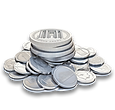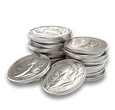Turkish Gold Coins and the Jewelry Trap: What Every Collector Should Know
- GoldsilverJapan

- May 19
- 3 min read
Updated: Jul 24

Introduction
In the vibrant world of Turkish culture, gold coins are more than currency—they’re gifts, heirlooms, and living expressions of wealth. For centuries, Ottoman and Turkish gold coins have played a central role in weddings, dowries, and ceremonial events.
But behind this enduring tradition lies a challenge for collectors: the jewelry trap. Many of these coins, once pristine, have been altered in ways that diminish their numismatic value. In this article, we explore how cultural usage can impact collector worth—and what signs to look out for.
Gold Coins in Turkish Tradition
From the grandeur of the Ottoman Empire to the modern-day Republic, gold coins like the Ottoman 250 kuruş, çeyrek altın (quarter gold), and ziynet altın have symbolized prosperity and respect. They’re gifted at weddings, baby showers, circumcision ceremonies, and more.
To serve ceremonial purposes, many of these coins are mounted on pins, sewn into garments, or worn as jewelry. Over decades, this practice has resulted in countless coins being holed, soldered, cleaned, or polished, often at the cost of their numismatic integrity.
The Collector’s Dilemma: Jewelry vs. Numismatic Value
To an untrained eye, a shiny coin might appear perfect. But in the world of coin collecting, condition is everything. Even subtle signs of alteration can significantly lower a coin’s collectible value.
Below are the top five red flags every collector should watch for when evaluating Turkish gold coins:
1. Mounting Marks (Holed Coins)
Coins used in jewelry are frequently pierced to hang or pin. Even if repaired later, holed coins typically receive a “Details” grade from grading services—instantly reducing their market value.
What to watch for:
Tiny punctures near the rim
Visible filling or patching
Asymmetrical edge contours
2. Solder Residue or Removed Mounts
Solder is often used to set coins into rings or bracelets. Even if mounts are removed, traces remain.
Look for:
Edge discoloration
Raised or flattened areas
Disrupted surface luster
3. Over-Polishing and Cleaning
To increase shine, many coins are harshly polished—especially if intended for display in jewelry. This destroys original surfaces, causing visible scratches and loss of detail.
Warning signs:
Unnaturally bright or reflective surfaces
Hairline scratches under angled light
Flattened or blurry design elements (e.g., the tughra)
4. Worn or Smoothed Details
Coins that have been handled frequently lose fine design features. High-relief details, mintmarks, and inscriptions may be rubbed away over time.
What to inspect:
Faded dates or scripts
Missing edge reeding
Low overall relief
5. “Details” Graded Coins in the Market
Coins with labels like “AU Details – Cleaned” or “XF Details – Holed” are authentic, but they’ve lost their ability to command top-tier prices.
Collector tip:Always seek coins certified by trusted grading services like PCGS or NGC. If not graded, examine under magnification and consult an expert before buying.
Cultural Value vs. Collector Value
Turkish gold coins used in jewelry are not worthless—they often carry deep sentimental value and high melt value. But if you're investing for numismatic returns, originality matters. A polished 1911 Ottoman 250 kuruş might look stunning in a pendant, but a slabbed AU-53 example could fetch 5x the price at auction.
Conclusion: Choose Carefully, Collect Wisely
The beauty of Turkish gold coins lies not only in their design but also in their journey—from imperial mints to family ceremonies. For collectors, the goal is balance: appreciate the history, but buy with your eyes open.
When in doubt:
Use a magnifying glass
Study grading standards
Seek trusted certification
That sharp eye will serve you well as you explore the fascinating world of Turkish coinage.
Want to explore certified Turkish gold coins or learn more about grading? Visit our expert guide or subscribe to GoldSilverJapan's collector newsletter for insider tips and new arrivals.










Comments